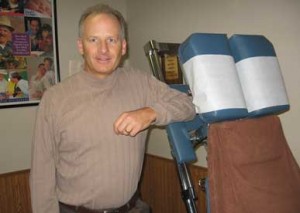It’s summer time!
Barbecues, or grill-outs, depending on where you live, baseball games, corner lemonade stands and kids everywhere. Whatever else is going on in the world, here in the Northern Hemisphere, your patients and hopefully you, are enjoying the summer.
Meanwhile, business goes on. The year is half over. 2010 will be here less than 6 months.
BAD NEWS
There has been a constant rain of bad news pouring down these last 6 months, and months before, about the dismal state of our national and world economy.
Whatever the real condition is, fear only makes it only worse. I have had chiropractors contact me and ask if they should continue in business, even when they were doing better than the year before. One was even having her best year ever.
We hear stories from other doctor who tell us that they know about chiropractors who are leaving the profession. In one state, we heard from its chiropractic association executive that 100 chiropractors, or about 10%, went out of business last year. We have read reports of how chiropractic incomes have fallen in the last several years by as much as 22%.
But it is hard to get any real concrete numbers about how D.C.’s are doing, at least for us. The fact is we mostly just know how the individual doctors with whom we work are doing.
So, we decided to do a random survey some of the offices with whom we work. The purpose was to give us a broader perspective and an overall average of how doctors and their teams were doing,
SURVEY RESULTS – GOOD NEWS
The sample included well established practices that we have worked with for years, as well as some we have only begun to work with at the start of this year. We compared office visits and collections for the first half this year with the first half of last year.
Again, this was a random sample. We did not cherry pick just the best offices.
Of all the offices in the sample, the average office increased in office visits by 11.8% in the first six months of this year compared to the first 6 months of last year.
The average office collections increased of 14.7% over the same time periods.

29% of the offices saw fewer visits this year than last year. The average percent down was 8%. These offices also saw an average of 4.7% less in collections.
However, 71% of the sampled offices were up, with an average of 19.7% in visits and 22.7% in collections. At least 4 of the offices, all well established, hit their “best-evers.”
You might wonder why the offices that did well – did well. And…
why the ones who were down – were down?
CAUSE OF INCREASES/DECREASES
Here’s what we know:
Looking at each office, case by case, we found that many of the offices that were down would have been even lower were it not for actions pushed by us. Not that down statistics are ever good, but compared to an average 40% drop in most retirement plans, 4.7 drop in collections is not that bad.
Second, in every down case there were weaknesses in one or more of eight major practice functions, what we call the 8 Essential Elements. (We will go over these in another article.)
- Some of these were weak because some part of the office was experiencing “growing pains.” For example, a team member was replaced and in the transition, there was a momentary drop in the numbers. Simply put, parts of the clinic were “under construction.”
- But another reason for lowered numbers trace to poor management of one of these 8 Essential Elements. We can pinpoint this exactly. Old habits die hard, and sometimes it takes extra time and nudging to be coaxed out of stubborn ideas that keep us from changing when we need to change.
The point is, it is not a mystery.
Offices that saw an increase in their numbers have been working hard to constantly improve critical functions of their practice and business. Some offices needed more external marketing, some more internal. Some needed better team performance, others better organization or collections. Most needed better management and leadership. One needed better business and accounting procedures.
Practice development is a result of constantly working ON the exact functions of the practice that need it the most. Most doctors and staff just work in the business, but the practices that grew also worked on their business.
WHY DOCTORS FAIL IN BUSINESS
There are many reason doctors fail, but they all go back to not effectively working on developing one or more of these 8 Essential Elements.
Plus, it is harder than it used to be. Like a fast time lapse science video, changes are occurring so rapidly in our social and economic environment that it is it is harder to keep up. As a doctor, you are trained to “doctor”, not be an executive manager and marketer. Plus… how can you run and develop your business while also focusing on the quality of your patient care?
WHAT YOU CAN DO
Success in today’s practice depends now on a new model or paradigm. It is one that is collaborative – working closely with doctors, staff, patients, the community and coaches, all as a networked team sharing ideas, and motivating each other for our greater goals.
It is not enough just to come to work, then “work”, and go home. You need to set some time aside each week to review your practice goals and monthly numbers. Then, you have to work with your team on specific areas of the practice that needs the most work.
You need to be a better practice and business executive, utilizing practice management tools.
Modern practice building is fun, really. Your practice can continue to do better and you CAN reach your goals. It may take a new approach, working with everyone as a team of players – each with specific roles and following effective and well rehearsed “plays.”
If you are not actively moving toward your goals, feel free to contact us. There are also other ethical and competent coaches and consultants who can help.
It is hard to go it alone.
Tiger Woods, probably the best golfer of a time, who receives regular chiropractic care, also has a coach.
We are happy to be yours.
# # #
Stay tuned for more on:
- The 8 Essential Elements
- New Practice Management Paradigm
- Practice Executive Toolkit





